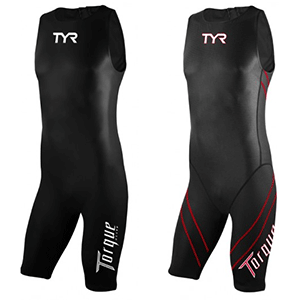
This is the third trial in my Winter series of testing the latest swimskins on the market. If you missed the first two, they are here.
From talking to folks who are familiar with this line, the $275 Zoot 2.0 is a big step up from the previous edition. This generation focuses a lot more on compression, and has a more slippery coating than the 1.0.
The surface on this newer iteration of the SpeedZoot sits in between the two TYR suits I tested. It has that paper feel of the TYR Elite but, the fabric is of a higher weight, such as that in the Torque Pro. It would seem intuitive that these suits mad of that heavier-weight fabric probably have a bit better compression and longevity. In a milieu where lighter is almost always better, this is probably one area where weight is not the imperative.
The seams are all taped inside and out on this suit, so it has no appreciable drag from seams. It comes with a breakaway zipper, and I'm not sure how I like this feature. I found it hard to just shrug my shoulder in order to break the clasp; I had to reach up and pull on it. No big deal really as all this gets done on the run up from the swim finish, and I'm sure with more practice I could just shrug it open. Only thing is that you do have to have someone help you get it on, unlike the suits with pull strings — unless you have a pull string on this suit, as is the case in the picture adjacent. I suppose not having the string makes the suit a little more slippery, but since that is on the back or top while swimming, probably not really a big deal.
I did this test in a short course yards pool. I used a medium black suit, and it seemed a perfect tight fit. (I'm 5'10" and weigh 173lbs.) The pool was hot, at 85 degrees, so I aborted the last set a few reps from the end.
After short warm up, first set with suit on and jammers underneath. 8x100: 1:17/17/17/18/17/17/17/17
Quick exit and jammer-only set: 1:20/20/20/20/19/20/20/20
Three-minute change and last set with suit back on: 1:18/17/17/17/17

Because of the heat in the pool, my steady power was producing a high heart rate and I was going to have to really change my efforts, and thus nullify any further results. But I got enough in to get what was in my mind a good statistical analysis of the two different swims. It came out to just a little under three seconds per hundred for me at my Ironman effort swim pace.
I did feel good compression on the suit like advertised, and I took just under one less stroke per lap with the suit. For me that is going from 16 to a stretched out 15 on the last stroke. As talked about before, some of this is due to the turn itself, but much is between the walls. Because of the high velocity of turns, these suits most likely get a higher percent of speed overall off the walls. So open water swims will be a little less overall, but for testing purposes you cannot beat the consistency of an exact measure pool.
One thing that became apparent to me in this trial was the heat factor. I'm sure all suits would be the same, but when I took it off after the first set, it was a huge relief. I don't wear swim caps, so that is not a factor in my heating up. Of course most triathlon swims are not in the 85 degree range, so not really a bid deal, but it was astonishing how hot the suit can get in already hot water. Many of you would not have an issue, but I've always been adversely affected by heat while reasonably impervious to cold.
All in all this seems a very well made suit that performed up to the high end of industry standards. I would have no qualms at all racing in this suit.


